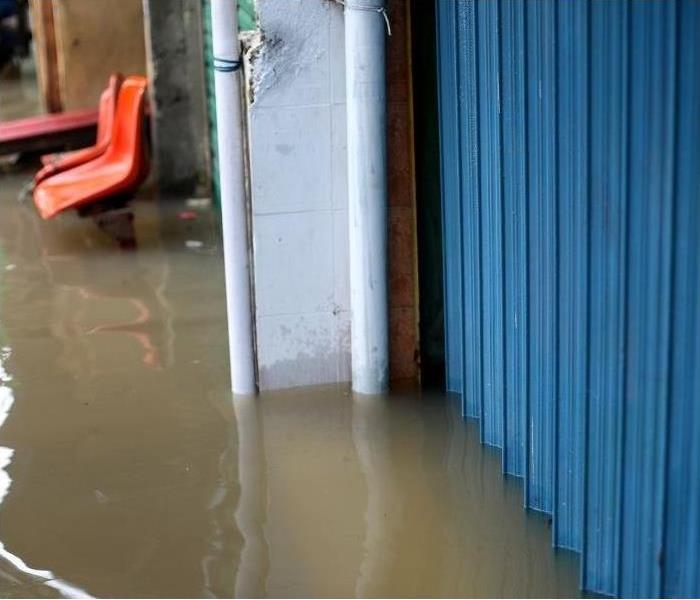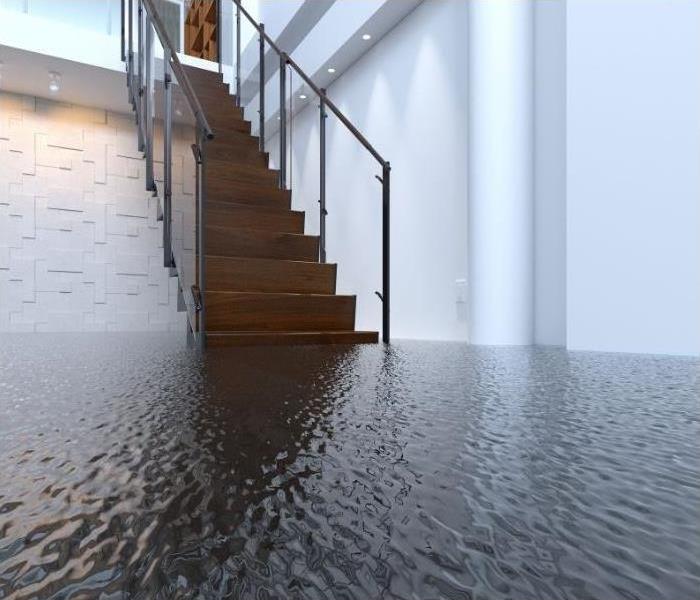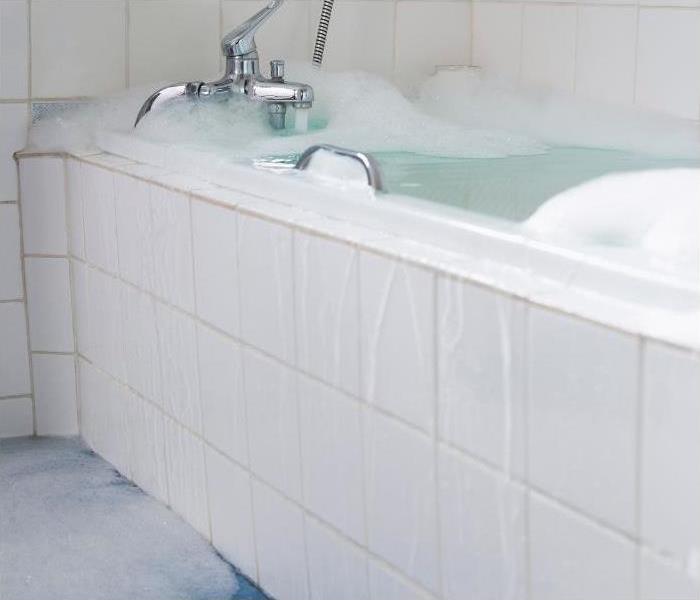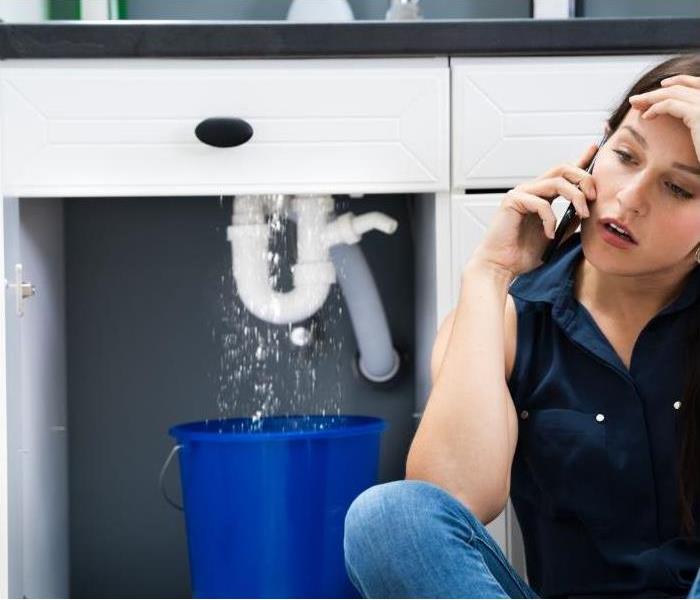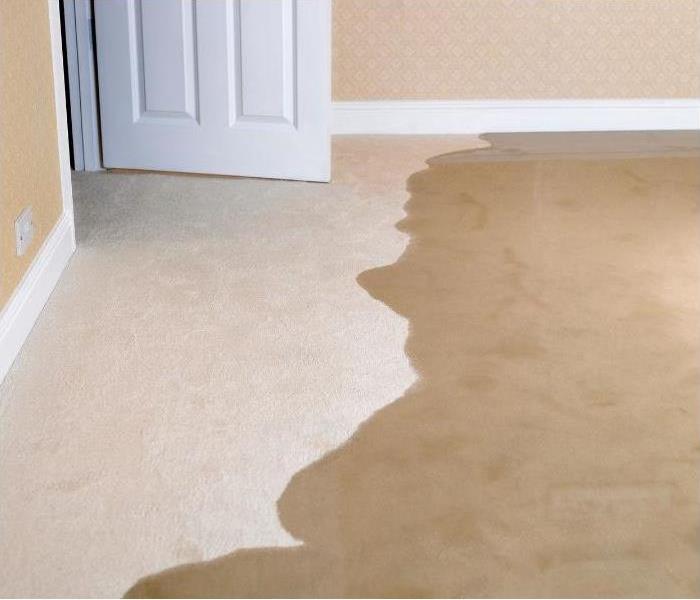Recent Posts
Finding the hidden menace: understanding mold in your home
1/29/2024 (Permalink)
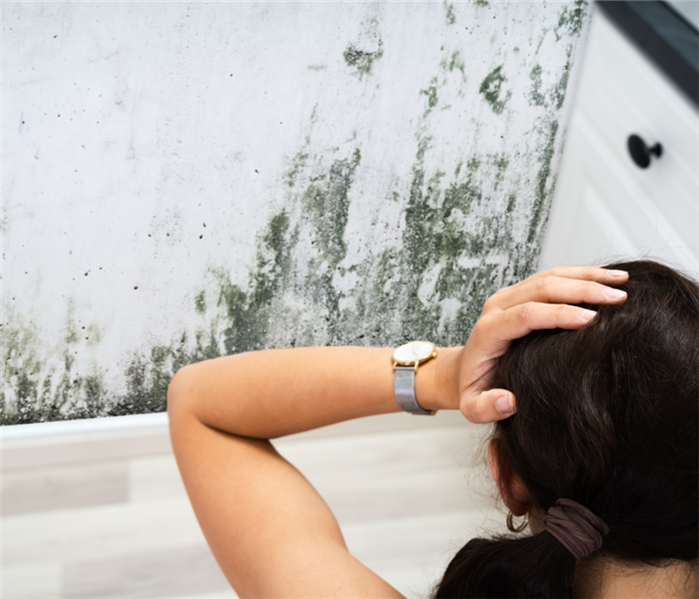 Mold growing on the walls
Mold growing on the walls
Imagine this: whether you're unlocking the entrance to your comfy house after a long day or coming into your bustling company space, ready to serve customers, a strange odor draws your attention. As you examine, your gaze falls on a faint yet threatening intruder—mold. This uninvited guest sees no difference between the comfort of your house and the professionalism of your business; it thrives in both. Mold is not simply an eyesore; it may also cause health problems and threaten the fundamental structure of your home. In this essay, we will look at the hidden nature of mold, including its sources, associated risks, and possible treatments. Knowing about and managing mold-related dangers is critical for maintaining an enjoyable and secure atmosphere for everybody, whether you own a house or a commercial property.
- What is mold?
Mold is a fungus of microscopic size that multiplies by air through spores and can occur both indoors and out in areas with high humidity. Mold is commonly seen in residential and commercial properties as fuzzy, discolored areas on walls, ceilings, and other surfaces. It reproduces by releasing microscopic spores into the air, which seek out wet places to settle and thrive in. Mold plays a crucial role in nature, but its presence indoors can be problematic.
- What causes mold to grow in residential and commercial buildings?
Understanding which conditions stimulate mold growth is critical. Mold flourishes in situations with high moisture levels, and several factors contribute to its spread:
- Leaks: Undetected leaks, whether from roofs, pipes, or appliances, provide an ongoing source of moisture, creating a fantastic breeding ground for mold.
- Water damage: If previous water damage, such as flooding or spills, fails to be properly handled, residual moisture may build up and promote mold growth.
- Poor ventilation: keeps moisture indoors, particularly in enclosed places such as restrooms, kitchens, and storage rooms.
- High humidity levels: Elevated humidity levels, which are common in humid places, create an environment conducive to mold growth.
- How can mold affect your health?
Mold can have a variety of effects on health, ranging from minor discomfort to serious respiratory problems. Here's a quick overview:
- Allergic reactions: Mold spores are allergens that can cause sneezing, runny nose, itchy eyes, and skin irritation.
- Respiratory issues: Mold exposure can exacerbate symptoms of asthma, such as coughing, wheezing, and difficulty breathing.
- Skin irritation: Direct contact with mold can irritate the skin.
- Individuals with compromised immune systems: may be more vulnerable to fungal infections caused by specific forms of mold.
- Can mold be detected before it becomes visible?
Yes, mold can be detected before it becomes visible. There are several ways to detect mold early on:
- Musty Odor: Mold often produces a distinct musty smell. If you notice an unusual odor in your home or building, it could indicate the presence of mold.
- Water Damage: Mold thrives in damp and moist environments. If you have experienced any water leaks or damage, it is important to thoroughly inspect and address any potential mold growth.
- Hidden Mold: Mold can grow in hidden areas such as behind walls, under flooring, or inside ceilings2. These areas may not be immediately visible, but if you suspect mold growth, a professional inspection may be necessary.
- Allergy Symptoms: Some individuals may experience allergic reactions, such as sneezing, coughing, or respiratory issues when mold is present. If you or others in your home are experiencing unexplained allergy symptoms, it could be a sign of hidden mold.
Regular examinations, even in places that are not easily visible, are critical for early discovery. Pay attention to hidden areas such as basements, crawl spaces, and under furniture. Controlling mold in its early stages is critical to preventing major damage and health problems.
- How can mold growth be prevented and controlled?
- Check that your home or company has adequate air circulation. Use exhaust fans in bathrooms and kitchens to minimize humidity and prevent moisture buildup. Leaks should be repaired as quickly as feasible. To prevent mold from forming, take immediate action if you notice a leaking roof, a plumbing problem, or a broken appliance.
- Ideal indoor humidity levels range from 30 to 50%. Use dehumidifiers in wet areas, especially basements, and consider utilizing air conditioners to minimize humidity during hot weather.
- Use mold-resistant products, especially in moisture-prone areas like bathrooms and basements. Mold-resistant drywall and coatings may give an additional layer of protection.
- Inspect your property regularly, focusing on moisture-prone areas. Regular exams can help discover and manage defects before they become serious issues.
Mold prevention is a constant endeavor that requires a combination of good practices and consciousness. By adopting these strategies, you create a less favorable atmosphere for mold, reducing the risk of infestations and related issues.
Mold is a difficulty that requires awareness and preventative measures, whether you run a pleasant house or a thriving business. Understanding the factors that contribute to mold growth and taking prompt action can help you keep your living or working environment healthy and friendly for everybody. Stay well-informed be proactive, and let the struggle against mold begin with awareness and instruction.
Investing in mold protection today safeguards the property and its occupants.
For professional mold remediation services, call SERVPRO at (480) 503-2090. Trust SERVPRO for reliable mold remediation, abatement, and restoration. Secure your space with us—prevention is the first line of defense.
Fire Safety for Businesses: Protecting Your Property
1/26/2024 (Permalink)
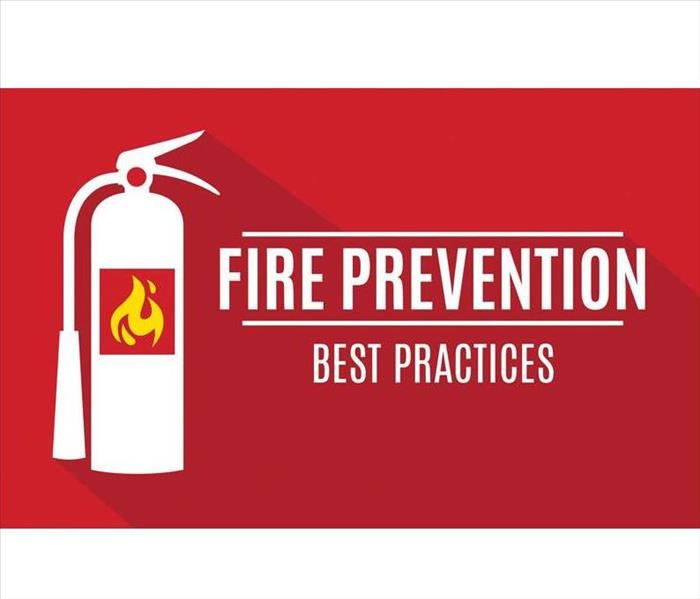 Fire prevention is important
Fire prevention is important
Fires are an important threat to companies, and the consequences can be disastrous. From economic damage to the potential loss of people's lives, businesses must develop efficient fire prevention procedures. In this article, we'll look at useful recommendations for businesses, covering fire prevention techniques, emergency response plans, and the importance of expert restoration services.
Understanding the most common causes of company accidents is the first step toward prevention. Electrical problems, heating and cooking equipment, combustible materials, and human error are frequently the cause of such events. Businesses may modify their fire security techniques according to the risks they notice.
Easy Fire Prevention Tips:
- Electrical safety requires regular maintenance. Ensure that all equipment is utilized appropriately and that any defective wiring is fixed promptly.
- For optimal building safety, consider purchasing fire-resistant materials and designs. To make your home safer, upgrade your insulation and roofing, and add fire-rated doors and windows.
- Properly keeping and handling combustible items is essential. Implement safe storage methods, train employees on handling dangerous substances, and keep flammable objects away from potential ignition sources.
- Establish designated smoking places away from flammable objects. To minimize the chance of accidents, discourage smoking around possible risks of fire.
Emergency Readiness: Planning and Action Strategies
- Establishing and communicating proper evacuation procedures is essential for ensuring safety and property. Regular employee training drills are essential for increasing knowledge of processes, and exit routes must be well-marked and easily accessible. This preemptive approach enables a timely and orderly response during an emergency.
- A reliable fire detection system is essential for effective emergency response. Installation and frequent maintenance of smoke detectors and alarms are critical. Consistent testing ensures their functionality in crucial situations, providing early warnings required for effective emergency response and evacuation.
- Plan for effective communication amid disasters. Develop a comprehensive communication plan that includes emergency contact information as well as communication tools. Ensuring that everyone is informed and on the same page may significantly enhance emergency coordination, leading to a safer and more effective response.
Getting Back on Track with Restoration Services:
- Acting Promptly
The aftermath of a fire requires rapid treatment. Acting quickly is crucial for preventing additional harm and starting the repair procedure. A timely assessment of the degree of the damage is required to establish a complete repair plan. This prompt response not only helps to save precious assets but also plays an important part in reducing downtime for your organization.
- Collaborating with Professional Restoration Services:
Professional restoration services are essential for a successful recovery. These experts bring a plethora of knowledge and experience to the table, resulting in a quick and effective cleansing and restoration procedure. From assessing structural damage to adopting effective recovery plans, their knowledge accelerates the restoration process, allowing your firm to resume normal operations as soon as feasible.
- Insurance Collaboration:
After a fire, navigating the aftermath can be financially tough. Working with your insurance provider can help relieve these pressures. Working closely with your insurance to document damage for claims is critical. Ensure that your insurance coverage includes restoration services since this not only protects your financial interests but also allows for a more efficient and comprehensive recovery process. A well-documented and collaborative strategy between restoration providers and your insurance carrier is critical to ensuring a successful repair outcome for your company.
Continue Researching and Stay Safe:
- Employee Fire Safety Instruction: A strong fire safety program starts with regular training for employees. Regular fire drills guarantee that personnel are not only aware of but also well-versed in evacuation methods. These drills increase familiarity, minimizing terror during genuine situations. Furthermore, offering continual education tools is critical to keeping everyone up to date on the most recent safety procedures. Continuous learning ensures that your staff is proactive in preventing and responding to fire incidents, resulting in a safer workplace.
- Creating a Safety Culture: Safety is more than simply a set of laws; it should get into all elements of your business. Recognizing and cheering safe behavior in employees develops a sense of responsibility and ownership. Positive reinforcement motivates employees to actively contribute to workplace safety. Businesses foster a culture of safety in which everyone feels empowered to disclose and handle possible dangers, resulting in a collective commitment to maintaining a secure and protected environment.
- Follow Local Regulations: Following local fire safety rules is essential for prudent business management, in addition to being a legal necessity. Regularly updating fire safety measures based on code changes is critical to being compliant and, more importantly, improving the safety of your property. Collaborating with local fire departments for compliance checks ensures that your company not only meets the required standards but also receives professional views and guidance. Businesses that are proactive in following local standards contribute to the general safety and well-being of their employees and customers.
Finally, protecting your business from fire involves a combination of proactive steps, preparation, and expert teamwork. Businesses that follow these fire protection techniques can considerably lower the probability of fire incidents and mitigate the possible damage to their property and personnel. Remember that a minor investment in preventive today might save your company from big losses later. Stay safe, and prepared, and preserve what's most important.
Remember the importance of prompt restoration when protecting your business from fire hazards. At SERVPRO, we provide exceptional fire damage restoration services that provide more than simply solutions; we also provide peace of mind and a secure commercial area. Call SERVPRO at (480) 503-2090 for emergency assistance, available 24 hours a day, seven days a week. Invest in the security of your business with us.
The Silent Threat: Understanding Smoke Damage in Homes
1/22/2024 (Permalink)
 Smoke damage in your home
Smoke damage in your home
Not only do the flames leave a mark after a fire, but so do other elements. The stealthy threat of smoke damage stays like a shadow, silently corroding the soul of home. Understanding this sneaky intruder is beyond merely knowledge; it is essential for sustaining the place of safety we call home.
- What frequently takes center stage in the aftermath of a fire, leaving a less obvious but equally dangerous threat lurking beneath the surface?
The aftermath of a fire is typically marked by visible destruction, but the often-overlooked threat of smoke harm quietly affects homes in ways that are not immediately noticeable. Aside from the obvious coloring and aromas, smoke residue infiltrates every nook and cranny, lowering indoor air quality and permeating materials. This invisible threat may pose long-term health consequences, such as breathing troubles and discomfort. Recognizing the numerous nuances of smoke damage is critical for a thorough restoration approach that extends beyond surface removal. Immediate action is required to alleviate not only obvious damage but also hidden, lingering dangers that can endanger a home's security and well-being.
- What is smoke damage, and how does it distinguish from being just the consequence of a fire?
Smoke damage is a convoluted combination of soot, ash, and toxic substances. Its insidious character stems from its tendency to enter and attach to surfaces, leading to discoloration and persistent scents throughout the home.
- How does smoke damage vary, and what role do different materials play in its severity?
Smoke damage varies depending on the type of smoke and the materials used:
Wet smoke is a result of sluggish burning with high water content.
- Dense and sticky, leaving greasy residues.
- Results in severe and difficult-to-clean damage.
Dry smoke results from quick burning with minimal water content.
- Lighter and thinner, penetrates surfaces deeper.
- Initially appears to be easy to clean, but can cause severe harm.
The Role of Materials in Damage Severity:
- The intensity of smoke damage is closely related to the type of material used.
- Synthetic materials, polymers, and chemicals emit dense smoke, causing further harm.
- Surface hardness and porosity influence smoke particle absorption and retention.
- What are the immediate implications of inhaling smoke residues?
Inhaling smoke remnants causes more than merely apparent harm and poses serious risks to one's health. The invisible particles in the air during a fire may contain toxins and cancer-causing agents, causing respiratory problems, eye discomfort, and long-term health risks. Recognizing these threats is critical for timely intervention and comprehensive restoration efforts. Acting quickly not only preserves immediate health, but it also reduces the risk of adverse health effects caused by exposure to toxic smoke residues.
- How can smoke damage influence the underlying structure of a house?
Smoke damage can threaten a home's structural integrity, posing a risk to both health and infrastructure. The invisible residue gradually infiltrates construction materials, weakening essential components. This balance necessitates an in-depth investigation and quick intervention to ensure the security of residents and the longevity of the home's structure. Furthermore, the continuous existence of smoke residue may result in leftovers odors, emphasizing the vital need for complete restoration. This not only prioritizes health, but also provides a pleasant place to live free of the long-term effects of smoke harm.
In the aftermath of a fire, a comprehensive understanding of the consequences of smoke damage is essential to effective mitigation. Beyond the visible damage, the silent threat infiltrates homes, affecting air quality and the strength of structures. Distinguishing smoke damage from fire aftermath reveals its detailed the structure of soot, ash, and toxic substances, which has a long-lasting influence.
Variations in smoke damage, caused by smoke type and substance, emphasize the distinguishing features of wet and dry smoke. Material choices increase the impact, with synthetics creating dense smoke and surface properties influencing particle retention. The inhalation of smoke remains causes health concerns, highlighting the importance of prompt identification and intervention.
Smoke damage not only threatens a home's construction but also produces persistent scents, underscoring the importance of comprehensive restoration. Swift, comprehensive action is essential to address both visible and hidden hazards, protecting properties from the long-term impacts of smoke damage.
To summarize, proactive understanding and early intervention are critical in navigating the aftermath of a fire. To protect our houses' safety and well-being, restoration operations should address not only visible damage but also the hidden complications of smoke damage. If damage has already occurred, call (480) 503-2090 for prompt and effective restoration, limiting the extent of the damage and preventing long-term problems like mold growth. Taking this proactive approach to recovering your house ensures that it regains its pleasant nature efficiently and successfully.
Winter ready: Tips for preventing and dealing with water damage
1/11/2024 (Permalink)
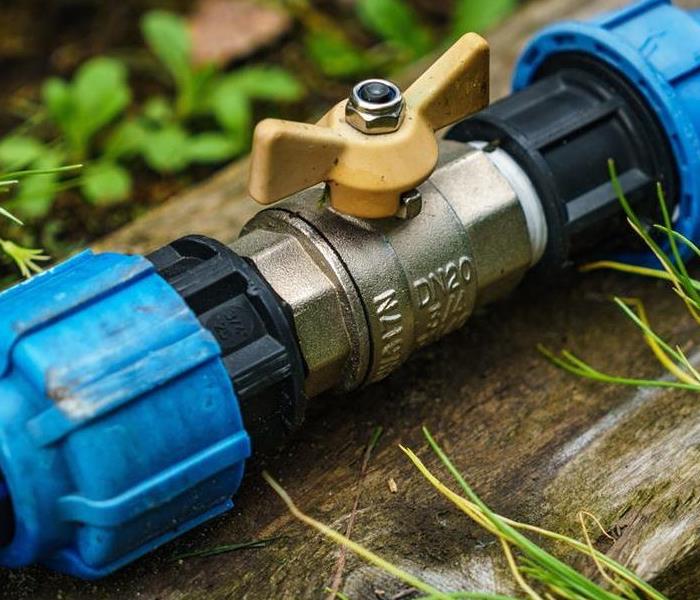 Protect your water pipes during winter time, to avoid future water damage.
Protect your water pipes during winter time, to avoid future water damage.
As now we’re in the winter season, you need to ensure your home is a fortress against the season's unique demands. Winter may bring its own set of challenges, especially when it comes to potential water damage. In this guide, we'll walk you through essential steps to fortify your home, making it ready for whatever weather comes its way. From shielding your pipes against the cold to maintaining a robust roof and drainage system, we've got the insights to keep your home safe.
- Protect the pipes before a freeze
Fortifying your pipes against freezing temperatures becomes crucial for preventing potential water damage and necessitating water restoration, damage repair, or cleanup. To shield your plumbing, insulate exposed pipes and faucets with heat tape or pipe insulation. This defensive layer minimizes the risk of pipes bursting due to freezing, thus reducing the likelihood of needing extensive water restoration services. Ensure to disconnect and store garden hoses, preventing ice formation that might lead to damage, potentially requiring water damage repair. Consider the installation of frost-proof outdoor faucets for added protection, mitigating the need for water cleanup efforts in the aftermath of freezing temperatures.
- Repair and protect the exterior of your home
It is imperative to fortify your home's exterior against potential water damage, emphasizing a strategic approach to water restoration. Initiating a thorough inspection is the first line of defense, identifying and promptly sealing any gaps, cracks, or holes to enhance your home's resilience against water infiltration.
When preparing your home for winter, paying close attention to your roof is vital in preventing potential water damage and minimizing the need for subsequent water restoration and cleanup. Start by inspecting your roof for signs of wear and tear, focusing on areas prone to holes and cracks. Check for missing or damaged shingles, as these can be entry points for water. During your inspection, be vigilant for water stains on the ceiling, peeling paint, or any unusual discoloration, as these can be indicators of water penetration. If you notice any issues, promptly fill holes and cracks using the appropriate roofing sealant.
This proactive step serves as a crucial defense against water infiltration, reducing the risk of interior damage and the subsequent need for water cleanup and restoration services.
- Do regular mold inspections
In your winter readiness checklist, don't overlook the importance of regularly inspecting your home for mold growth. Vigilance in this regard can significantly contribute to minimizing the risk of water damage and subsequent demands for water restoration and cleanup services. Pay particular attention to areas prone to moisture buildup, such as kitchens, bathrooms, and attics. Watch for visible signs of mold, such as discoloration, musty odors, or peeling wallpaper. Additionally, be mindful of any recent water leaks or flooding, as these incidents can create an ideal environment for mold growth. If you detect any suspicious signs, take immediate action to address the issue. Timely mold inspection and remediation not only protect your home's structural integrity but also diminish the likelihood of requiring extensive water damage repair.
- Maintain a clean drain system
Ensuring your drain system remains clear and functional is a fundamental aspect of winter preparedness, vital in reducing the risk of water damage and the subsequent need for water cleanup and restoration services. Regularly inspect and clean your gutters and downspouts, removing any debris that might obstruct proper drainage.
Clogged gutters can lead to water overflow, potentially causing damage to your home's foundation or siding. As part of your routine maintenance, also check for any signs of water pooling around your property, which could indicate drainage issues. This simple yet effective step contributes to a comprehensive approach to winter readiness.
At SERVPRO, we realize the importance of a secure home. If you've already faced the aftermath of water damage, our expert team is here to provide swift and reliable restoration services. We specialize in water damage repair, cleanup, and restoration, ensuring your home bounces back from adversity. Call us today at (480) 503-2090 for a resilient, ready home that stands strong in the face of weather challenges.
Here's Why an Emergency Plan for Your Business Matters
10/24/2023 (Permalink)
When an unexpected disaster occurs, many businesses struggle to fully recover in the aftermath. Having a plan in place to be prepared for emergencies can make the difference between surviving a disaster or not. Does your business have an emergency readiness plan?
How businesses are impacted by disasters
Some businesses may never recover following a disaster, having lost too much time, clientele or inventory during the recovery process. A fire to a business is devastating and can cause it to completely shut down; for many businesses regardless of size, extensive downtime can mean a huge financial impact. According to the Federal Emergency Management Agency (FEMA), almost 40 percent of small businesses never reopen their doors after a disaster. However, the ones that do survive usually have a preparedness plan in place.
What is an emergency readiness plan?
While an emergency readiness plan can’t stop a disaster from happening, it can help a business be ready to handle a disaster during the event and be better prepared to recover after a disaster. One-way SERVPRO helps a business be prepared is with the ERP profile. Pre-planning can serve as an insurance policy aimed at peace of mind. And knowing you are "Ready for whatever happens" speaks trust to your clients and employees that in the event your business is affected by a disaster, they don’t necessarily have to be.
By developing a SERVPRO Emergency READY Profile for your business, you minimize business interruption by having an immediate plan of action. Knowing what to do and what to expect in advance is the key to timely mitigation and can help minimize how water and fire damage can affect your business.
The SERVPRO Emergency READY Profile Advantage
- A no-cost assessment of your facility.
- A concise Profile Document that contains only the critical information needed in the event of an emergency.
- A guide to help you get back into your building following a disaster.
- Establishes your local SERVPRO Franchise Professional as your disaster mitigation and restoration provider.
- Identification of the lone of command for authorizing work to begin.
- Provides facility details such as shut-off valve locations, priority areas, and priority contact information.
Contact SERVPRO of Central Phoenix to get your business ready
SERVPRO of Phoenix is well-versed in disaster recovery and remediation. If you want to better prepare your business for any unexpected disaster, contact SERVPRO of Central Phoenix to learn more. You can also read more about SERVPRO’s ERP to understand how it can help prepare you for any emergency and offers helpful tips and best practices. Already experienced an unexpected disaster and need help? Call SERVPRO 24/7 at 602-386-4268. We’re faster to any disaster and can help you recover and get back to business in no time!
The Many Challenges of Commercial Flood Damage Cleanup
9/25/2023 (Permalink)
Like other types of water damage, commercial flood damage brings its own unique challenges. Water is heavy, and the more exposure typically dry structural materials have to it, the more weakened they become. Add on top of that the potential toxins or possible sewage that groundwater has the potential to contain, and the need for flood damage cleanup and expedited mitigation for the property becomes even more crucial.
When SERVPRO® technicians handle commercial water damage in a Phoenix business, they typically suggest closing the property and putting up barriers with the purpose of preventing cross-contamination as well as limit foot-traffic for safety from issues such as slip-and-fall accidents on wet floors. SERVPRO® understands the challenges of closing a business during repair. Every hour spent cleaning up is an hour of lost revenue and productivity. We take all the proper precautions for safety while working as quickly as possible to negate the impact of a closed business.
Locating Water Damaged Structural Components
During restoration services, the technicians investigate the water damage affected areas of the property to determine all areas with elevated moisture. When necessary, cautious demolition tactics such as removal of sheetrock and disposal of wet insulation are necessary for the most thorough drying. Water-impacted building materials such as baseboards, carpet, and flooring that do not have the potential for simple cleaning unfortunately require disposal.
Steps to Water Damage Restoration Process
After initial damage inspection and assessment, SERVPRO’s® highly trained professionals go through a substantial water removal and water extraction process to get as much water off the premises as possible. This step removes the majority of the water using powerful pumps and truck-mounted vacuum units to quickly remove hundreds or thousands of gallons of water from the property. After the initial water removal, drying and dehumidification takes place to prevent further material damage, warping or even mold. Cleaning, repair and restoration are the final steps of the process.
Vent Inspection and Cleaning
If the HVAC system was running after flood damage, the potential for the ventilation system to contain airborne contaminants is a concern, and thorough cleaning and disinfection of the ductwork is standard practice to protect the commercial property.
Return to Sanitary Standards for Reopening the Business
SERVPRO® technicians have the equipment and proprietary solutions to bring properties back to sanitary condition. In most cases, techs clean water-affected surfaces, eradicating 99.9% of bacteria and microbes to ensure the property is safe for employees and the public once again.
Whether water damage is created by the monsoon season in Phoenix or another issue, there are many challenges associated with commercial flood damage cleanup. The highly trained staff at SERVPRO® of Central Phoenix can get the job done, regardless of the cause. Our business is getting you back in business.
SERVPRO® of Central Phoenix at 602-386-4268 knows commercial flood damage requires expedited action to limit downtime and destruction to a business. The certified technicians work until the property is returned to its preloss condition "Like it never even happened."
Storm Damage Services Are Vital to Any Phoenix Business
9/13/2023 (Permalink)
When businesses experience storm damage, the costs are multiplied by not only what the expense will be to repair the damage, but lost business during the time repairs are being done. When Phoenix businesses experience storm damage by our destructive monsoons, the costs can add up quickly, so working with a business such as SERVPRO® of Central Phoenix can make a huge difference in how well a business recovers after commercial storm damage is experienced.
The cost of storm damage to a business
When monsoons or other violent storms cause damage to a business, regardless of size, the business can suffer significantly until the damage is repaired. First, the initial damage, which can include broken windows, soaked flooring and furniture, damaged walls, and more, can be unsightly if not unsafe for both customers and employees. In many cases, businesses have to shut down fully or partially until the damage is assessed and repaired. In addition to the cost of repairs and lost business, productivity can suffer significantly even if the business remains open. The sooner a business can get fully restored and up to speed, the less costly the storm damage is to the company’s bottom line overall.
Why commercial storm damage presents a unique challenge
Storm damage to commercial properties present a unique challenge to restoration specialists. Unlike residential properties, commercial properties may not be able to vacate the premises while restoration work is being done in order to keep the business up and running. Also, depending on the size of the business building itself, the restoration process can be on a much larger scale, especially those commercial building with multiple floors. Oftentimes, heavy or expensive commercial equipment has suffered from storm damage and needs to be restored or removed. And of course, while storm damage is never convenient for either a homeowner or a commercial property owner, commercial storm damage can be significantly more costly as more time goes on until the damage is repaired. With SERVPRO of Phoenix’s 24-hour emergency service, we can be faster to any disaster.
The timeline for water damage on commercial properties
Water damage restoration specialists understand the timeline of water damage and the costs associated. Within minutes of storm damage, water can spread quickly and cause damage to flooring, furniture, walls, equipment and more. Within 24 hours, drywall can swell, materials start to break down, and a musty odor can form. After 48 hours, windows and doors can swell, paint blisters and wood floors can warp. If damage is left unaddressed any longer than a week, significant mold damage can set it, greatly increasing costs to businesses. There are many major employers in Phoenix but large or small, water damage can be costly to a company.
Why business need to work with a commercial restoration specialist
Unfortunately, most companies don’t seek out commercial storm damage services until they need one and by then, the clock is ticking. Ideally, companies should identify a company that specializes in commercial storm damage restoration and other related services so they’re prepared should disaster strike. If your company is seeking a commercial restoration company as part of their emergency-ready plan, contact SERVPRO® of Central Phoenix at 602-386-4268.
Why Bathrooms Are Where Much Water Damage Occurs
9/7/2023 (Permalink)
Much of the flooding and other water damage experienced in homes starts in the bathroom. Bathrooms are a common source of water damage which can be created by overflowing toilets, burst under-sink pipes, overflowing bathtubs, or water pipe leaks underneath the flooring. Luckily, SERVPRO of Central Phoenix has water restoration specialists to help recover from the water damage.
Water damage isn't easy to detect
While an overflowing toilet or bathtub is maddening, a homeowner is usually instantly aware when the damage happens, assuming they are home at the time to witness the event. Unfortunately, there are leaks that can happen behind the walls, going on for days, weeks or even months that don’t get found until the damage is significant, including the presence of mold and resulting odors. That’s why water damage in bathrooms can cause little to considerable damage. Even the more “obvious” issues can go undetected if the homeowner is out of town for any significant amount of time, such as “snowbirds” who only frequent the state part-time. A telltale sign of a whooshing sound may be detected in other rooms, but water sounds are common in a bathroom and therefore may be ignored. Water damage needs immediate attention to help restore the bathroom quickly once it’s been detected.
When water damage occurs
When the SERVPRO water damage team arrives at the home, they immediately get to work to assess the extent of the damage and determine the source of the damage if it wasn’t previously identified. First, they’ll inspect the damage and make an appraisal in order to address the issue. Next, they’ll use their expertise with advanced equipment to extract the water using powerful pumps and vacuum units to quickly remove water from your property, which helps prevent secondary water damage and mold growth. After that is the drying and dehumidification to help prevent odors and mold from growing. Next, they’ll clean all the restorable items and structures damaged by the water using several proven techniques as well as sanitizing treatments to remove odors and deodorize your property.
Restoration and rebuilding may be necessary
The last step is restoration, restoring your home to its pre-water damage condition. This might include minor repairs such as replacing drywall, tile floor repair, painting, or installing new carpeting. Depending on the extent of the damage, the repairs may be more substantial which can include tarping, boarding up, packing and moving, etc. SERVPRO of Central Phoenix can simplify the restoration process by handling both the initial water damage mitigation and rebuilding the affected areas that will bring a building back to full functionality…like it never happened!
Bathrooms are a typical area when it comes to residential water damage but choosing the best water damage restoration company can make the recovery process easier. Contact us at 602-386-4268 to get your water damage handled.
How to Bounce Back After Water Damage to Your Office Building
10/24/2022 (Permalink)
The pipe burst under the sink in the bathroom of your office building or under the breakroom sink, and now you’re facing an overwhelming task for cleanup and repairs. The floors and walls are wet, and it appears that you may have to disrupt daily operations for a while so that professionals can restore the office. Nowadays, even a few days of downtime can have a big impact on businesses. Here’s what you need to do so your business can bounce back quickly.
Right after the flood occurs, act fast
It’s a good idea to call us right away after you experience water damage because excess water can cause damages to the structure of the building as well as to floor tiles and walls. In addition, if you allow water to stand inside the building for more than 48 hours, the mold may start to grow, which can cause health effects. While your knee-jerk reaction is to grab a mop and try to clean it up yourself, it’s best to leave it to the professionals who know how to clean up water damage, so no further damage occurs.
The pros at SERVPRO
Our commercial water damage SERVPRO technicians in Phoenix are highly trained and understand the importance of mitigating moisture quickly to stop further damage from occurring. The team can use extractors, vacuums, or pumps to remove water from the structure. After the migration phase, the team dries the area. Our crew may employ air movers or axial fans to dry the office. We may also utilize dehumidifiers to reduce humidity and increase evaporation. In addition, we’ll utilize dehumidifiers to pull in moisture and return dry, warm air inside the office environment. This step helps increase the drying phase and keep additional damage from unaddressed moisture from causing more damage.
Fighting secondary damage
We work fast to dry the area to prevent mold growth and to reduce the chances of other secondary issues such as wood rot from occurring. The crew can also pack out materials and contents inside the office. We itemize, categorize, and store each item in a dry and safe area on or off-site until the restoration process is complete. We know that it is essential to keep your office functioning on a daily basis, which is why you can expect our techs to work quickly and to strive to get the job done right. We also ensure no moisture is present to fight against the possibility of lingering odors.
SERVPRO of Central Phoenix provides commercial water damage restoration services that can restore your office when possible. Call us at (602) 386-4268 any time of the day or night to schedule an appointment if you experience water . We are here to help and can return your office to its preloss condition and help your business bounce back quickly.
How to Keep Damage to a Minimum After a Flood in Your Home
9/15/2022 (Permalink)
Nobody plans to have a flood in their home, so they seldom learn about what should be done if their home becomes flooded. Knowing some crucial steps to take after water damage occurs can keep additional damage to a minimum. If your home experiences a significant water issue such as a burst pipe, the first step most homeowners take is to do whatever is needed to stop the water. Here are a few more tips to minimize damage to your home after a flood.
Move any items that can be affected by water
If there are rugs or carpets in the flooded area that you can pick up, remove them immediately. Take them outside and drape them over something sturdy to let the water drain out and the item air out to prevent any mildew. Water can do a significant amount of damage in a short amount of time, especially to items that have a color of any kind. Shoes, bags, area rugs, pet gear, books, or magazines, should all be moved. Most items won't suffer significantly from water damage if handled quickly. If any items that are perishable in nature are saturated with water, simply dispose of the item to prevent the risk of contamination. This includes kids’ toys, food, chew toys, pet food, or anything that is quickly impacted by water.
Remove as much water as you can up until SERVPRO arrives
Once the floor is clear of at-risk items, you can focus on sopping up as much standing water as possible until help arrives. Towels or a mop may be enough to get the mess under control, or you may want to use a shop vacuum if you have one that accommodates water. While the SERVPRO water remediation team will be able to help with water cleanup, the sooner you can remove standing water, the better, until professionals arrive with equipment designed to extract all water completely.
Prop up furniture and other larger unmovable items
Some larger items affected by water may not be able to get moved out of the water-impacted area by the homeowner because of size or weight. If that is the case, there are still steps you can take to minimize the damage until help arrives. Use aluminum foil or small wooded blocks to raise furniture off wet floors, especially carpeted ones, to minimize damage. Doing this protects your furniture from prolonged water exposure and possibly reduces the risk of discoloration of carpeting or transfer of furniture coloring onto your carpet. Whatever you can do to get larger pieces as much out of standing water as possible will help. Wipe down any wood furnishing that has become damp to potentially minimize warping.
Water damage in a home is always unexpected. Act quickly to stop the water source, then contact SERVPRO of Central Phoenix at 602-386-4268 for water remediation. We are available 24/7 to help with any water emergency you may have and will respond quickly to your call.






 24/7 Emergency Service
24/7 Emergency Service




